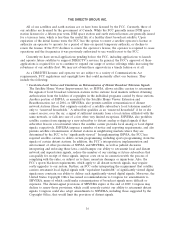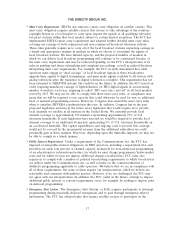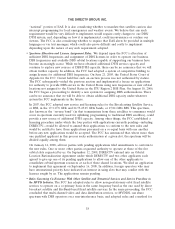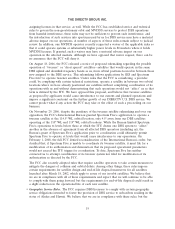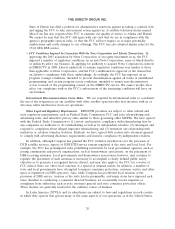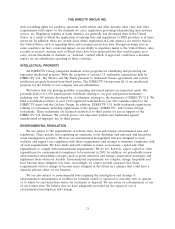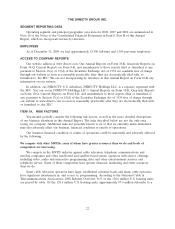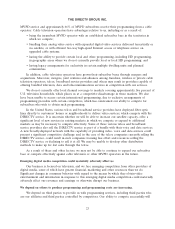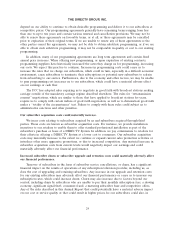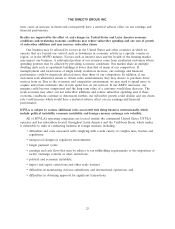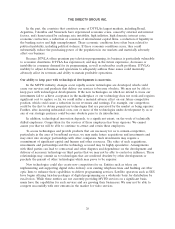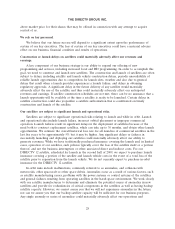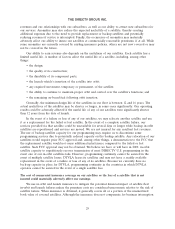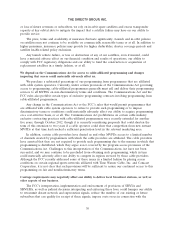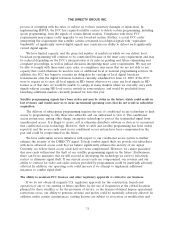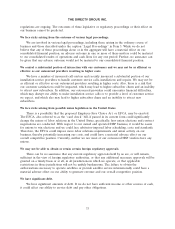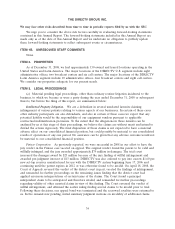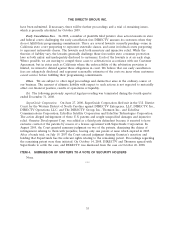DIRECTV 2008 Annual Report Download - page 38
Download and view the complete annual report
Please find page 38 of the 2008 DIRECTV annual report below. You can navigate through the pages in the report by either clicking on the pages listed below, or by using the keyword search tool below to find specific information within the annual report.THE DIRECTV GROUP, INC.
turn, cause an increase in churn and consequently have a material adverse effect on our earnings and
financial performance.
Results are impacted by the effect of, and changes in, United States and Latin America economic
conditions and weakening economic conditions may reduce subscriber spending and our rate of growth
of subscriber additions and may increase subscriber churn.
Our business may be affected by factors in the United States and other countries in which we
operate that are beyond our control, such as downturns in economic activity in a specific country or
region, or in the MVPD industry. Factors such as interest rates and the health of the housing market
may impact our business. A substantial portion of our revenues come from residential customers whose
spending patterns may be affected by prevailing economic conditions. Our market share in multiple
dwelling units such as apartment buildings is lower than that of many of our competitors. If
unemployment and foreclosures of single family residences increase, our earnings and financial
performance could be negatively affected more than those of our competitors. In addition, if our
customers seek alternative means to obtain video entertainment, they may choose to purchase fewer
services from us. Due to the economic and competitive environment, we may need to spend more to
acquire and retain customers who in turn spend less on our services. If our ARPU decreases, our
margins could become compressed and the long term value of a customer would then decrease. The
weak economy may affect our net subscriber additions and reduce subscriber spending and, if these
economic conditions continue or deteriorate further, our subscriber growth could decline and our churn
rate could increase which would have a material adverse effect on our earnings and financial
performance.
DTVLA is subject to various additional risks associated with doing business internationally, which
include political instability, economic instability, and foreign currency exchange rate volatility.
All of DTVLA’s operating companies are located outside the continental United States. DTVLA
operates and has subscribers located throughout Latin America and the Caribbean Basin, which makes
it vulnerable to risks of conducting business in foreign markets, including:
• difficulties and costs associated with complying with a wide variety of complex laws, treaties and
regulations;
• unexpected changes in regulatory environments;
• longer payment cycles;
• earnings and cash flows that may be subject to tax withholding requirements or the imposition of
tariffs, exchange controls or other restrictions;
• political and economic instability;
• import and export restrictions and other trade barriers;
• difficulties in maintaining overseas subsidiaries and international operations; and
• difficulties in obtaining approval for significant transactions.
25



